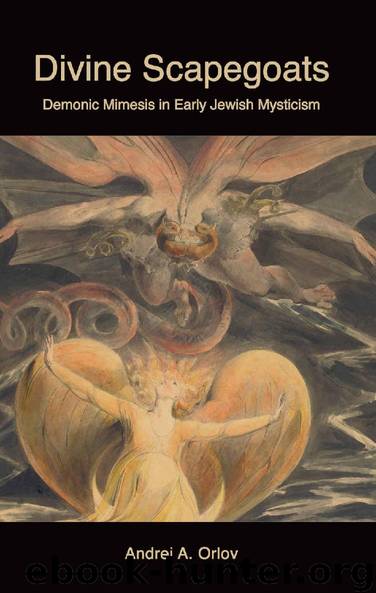Divine Scapegoats: Demonic Mimesis in Early Jewish Mysticism by Andrei A. Orlov

Author:Andrei A. Orlov [Orlov, Andrei A.]
Language: eng
Format: epub
Publisher: State University of New York Press
Published: 2015-02-10T07:00:00+00:00
The Curses of Azazel
1. The general scholarly consensus holds that the apocalypse was composed after 70 CE and before the end of the second century CE. The depiction of the destruction of the Temple in chapter 27 and the peculiar interest in the idea of the celestial sanctuary represented by the divine Chariot hint at the fact that the earthly sanctuary was no longer standing. Another significant chronological marker is established by the second century work—the Clementine Recognitiones 32–33 which provides one of the earliest external references for the dating of the Apocalypse of Abraham. On the date of the Apocalypse of Abraham, see G.H. Box and J.I. Landsman, The Apocalypse of Abraham. Edited, with a Translation from the Slavonic Text and Notes (TED, 1.10; London, New York: The Macmillan Company, 1918) xv–xix; B. Philonenko-Sayar and M. Philonenko, L’Apocalypse d’Abraham. Introduction, texte slave, traduction et notes (Semitica, 31; Paris: Librairie Adrien-Maisonneuve, 1981) 34–35; R. Rubinkiewicz, “Apocalypse of Abraham,” The Old Testament Pseudepigrapha (2 vols.; ed. J.H. Charlesworth; New York: Doubleday, 1983–1985) 1.681–705 at 683; idem, L’Apocalypse d’Abraham en vieux slave. Introduction, texte critique, traduction et commentaire (ŹM, 129; Lublin: Towarzystwo Naukowe Katolickiego Uniwersytetu Lubelskiego, 1987) 70–73; A. Kulik, “К датировке ‘Откровения Авраама,’ ” In Memoriam of Ja. S. Lur’e (eds. N.M. Botvinnik and Je.I. Vaneeva; St. Petersburg: Fenix, 1997) 189–195; idem, Retroverting Slavonic Pseudepigrapha: Toward the Original of the Apocalypse of Abraham (TCS, 3; Atlanta: Scholars, 2004) 2–3.
2. Cf. C. Fletcher-Louis, “The Revelation of the Sacral Son of Man,” in: Auferstehung-Resurrection (eds. F. Avemarie and H. Lichtenberger; Tübingen: Mohr/Siebeck, 2001) 282; A.A. Orlov, “Eschatological Yom Kippur in the Apocalypse of Abraham. Part I. The Scapegoat Ritual,” in Symbola Caelestis. Le symbolisme liturgique et paraliturgique dans le monde chrétien (Scrinium 5; eds. A. Orlov and B. Lourié; Piscataway: Gorgias Press, 2009) 79–111.
3. With respect to the Yom Kippur traditions in the Apocalypse of Abraham, see L.L. Grabbe, “The Scapegoat Tradition: A Study in Early Jewish Interpretation,” JSJ 18 (1987) 165–179 at 157; R. Helm, “Azazel in Early Jewish Literature,” AUSS 32 (1994) 217–226 at 223; B. Lourié, “Propitiatorium in the Apocalypse of Abraham,” in The Old Testament Apocrypha in the Slavonic Tradition: Continuity and Diversity (eds. L. DiTommaso and C. Böttrich; TSAJ, 140; Tübingen: Mohr/Siebeck, 2011) 267–277; D. Stökl Ben Ezra, “Yom Kippur in the Apocalyptic Imaginaire and the Roots of Jesus’ High Priesthood,” in Transformations of the Inner Self in Ancient Religions (eds. J. Assmann and G. Stroumsa; Leiden: Brill, 1999) 349–366; idem, “The Biblical Yom Kippur, the Jewish Fast of the Day of Atonement and the Church Fathers,” SP 34 (2002) 493–502; idem, The Impact of Yom Kippur on Early Christianity: The Day of Atonement from Second Temple Judaism to the Fifth Century (WUNT, 163; Tübingen: Mohr/Siebeck, 2003) 94.
4. Regarding heavenly Temple/heavenly priesthood traditions, see J.L. Angel, Otherworldly and Eschatological Priesthood in the Dead Sea Scrolls (STDJ, 86; Leiden: Brill, 2010); V. Aptowitzer, “The Celestial Temple as Viewed in the Aggadah,” in Binah: Studies in Jewish Thought (ed. J. Dan; Binah: Studies in Jewish History, Thought, and Culture, 2; New York: Praeger, 1989) 1–29; M.
Download
This site does not store any files on its server. We only index and link to content provided by other sites. Please contact the content providers to delete copyright contents if any and email us, we'll remove relevant links or contents immediately.
| Baha'i | Cults |
| Demonology & Satanism | Eckankar |
| Egyptian Book of the Dead | Freemasonry |
| Messianic Judaism | Mysticism |
| Scientology | Theism |
| Tribal & Ethnic | Unitarian Universalism |
The Four Agreements by Don Miguel Ruiz(6322)
Breaking Free by Rachel Jeffs(4013)
The Hatha Yoga Pradipika (Translated) by Svatmarama(3077)
120 Days of Sodom by Marquis de Sade(2943)
Member of the Family by Dianne Lake(2262)
The Tao of Physics by Fritjof Capra(2168)
The Psychedelic Gospels: The Secret History of Hallucinogens in Christianity by Jerry B. Brown(2073)
The Road to Jonestown by Jeff Guinn(1983)
Going Clear: Scientology, Hollywood, and the Prison of Belief by Lawrence Wright(1884)
Going Clear by Lawrence Wright(1873)
Uriel's Machine by Christopher Knight(1823)
The Grand Grimoire: The Red Dragon by Author Unknown(1711)
The Gnostic Gospel of St. Thomas by Tau Malachi(1680)
Key to the Sacred Pattern: The Untold Story of Rennes-le-Chateau by Henry Lincoln(1556)
The Malloreon: Book 02 - King of the Murgos by David Eddings(1518)
Waco by David Thibodeau & Leon Whiteson & Aviva Layton(1488)
The New World Order Book by Nick Redfern(1485)
The Secret of the Temple by John Michael Greer(1422)
The Initiatory Path in Fairy Tales by Bernard Roger(1396)
